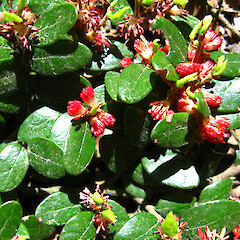Fuscospora solandri
Common name
black beech, tawhairauriki
Synonyms
Fagus solandri Hook.f., Nothofagus solandri (Hook. f.) Oerst. var. solandri, Nothofagus solandri (Hook.f.) Oerst.
Family
Nothofagaceae
Flora category
Vascular – Native
Endemic taxon
Yes
Endemic genus
No
Endemic family
No
Structural class
Trees & Shrubs - Dicotyledons
NVS code
The National Vegetation Survey (NVS) Databank is a physical archive and electronic databank containing records of over 94,000 vegetation survey plots - including data from over 19,000 permanent plots. NVS maintains a standard set of species code abbreviations that correspond to standard scientific plant names from the Ngä Tipu o Aotearoa - New Zealand Plants database.
NOTSVS
Chromosome number
2n = 26
Current conservation status
The conservation status of all known New Zealand vascular plant taxa at the rank of species and below were reassessed in 2017 using the New Zealand Threat Classification System (NZTCS) – more information about this can be found on the NZTCS website. This report includes a statistical summary and brief notes on changes since 2012 and replaces all previous NZTCS lists for vascular plants.
Please note, threat classifications are often suggested by authors when publications fall between NZTCS assessment periods – an interim threat classification status has not been assessed by the NZTCS panel.
- Conservation status of New Zealand indigenous vascular plants, 2017 . 2018. Peter J. de Lange, Jeremy R. Rolfe, John W. Barkla, Shannel P. Courtney, Paul D. Champion, Leon R. Perrie, Sarah M. Beadel, Kerry A. Ford, Ilse Breitwieser, Ines Schönberger, Rowan Hindmarsh-Walls, Peter B. Heenan and Kate Ladley. Department of Conservation. Source: NZTCS and licensed by DOC for reuse under the Creative Commons Attribution 4.0 International licence.
2017 | Not Threatened
Previous conservation statuses
2012 | Not Threatened
2009 | Not Threatened
2004 | Not Threatened
Brief description
Forest canopy tree in lowland dry areas with a dark sooty trunk bearing small leathery leaves arranged along the twig and that are pale underneath and with slightly incurved margins. Leaves 10–15 mm long, with a rounded tip. Flowers and fruits inconspicuous, but these and new leaf growth can change a trees colour.
Distribution
Endemic. New Zealand: North Island (very rare north of the Central Volcanic Plateau and East Cape. Te Hauturu-o-Toi / Little Barrier Island appears to be the current northern limit), South Island.
Habitat
Lowland to montane forest. At times the canopy dominant and forming its own distinctive forest type.
Detailed description
Tree up to 25 m tall, wood pinkish to yellowish when fresh, often with darker patches. Bark rough, furrowed, charcoal black. Trunk 1 m or more diam. Branches numerous, stout, spreading, “pagodaform”. Petioles 1–2 mm. Leaves 10–15 × 5–10 mm, narrow- to elliptic-oblong, obtuse, obliquely cuneate at base, apex often apiculate, leathery, glabrous, dark green above, undersides clad in greyish white tomentum, venation distinct on both surfaces. Domatia absent. Male inflorescences 1–4 per branchlet, on short sparsely pubescent peduncles; flowers 1–2, sessile. Perianth broadly-campanulate, 2 × 3 mm, shallowly and obtusely 4–5-lobed; stamens 8–17, anthers 2–3 mm long, dark red. Female inflorescences ovoid, 1–2 per branchlet, pubescent to pilose hairy, sessile, flowers 1–3. Lateral flowers trimerous, terminal ones dimerous; stigmas clavate. Cupule 6–7 mm, glabrous or pubescent, 3-partite. Nuts up to 7 mm long, wings broad at base, narrowed to apex.
Similar taxa
Differs from mountain beech (Fucospora cliffortioides) by the oblong leaves with obtuse apices, by the obvious leaf venation and sparsely hairy ovary. Although closely allied to mountain beech and readily forming hybrids with it, both beeches shoudl be regarded as distinct species not varieties of each other.
Flowering
September–December
Flower colours
Red/Pink
Fruiting
November–April
Propagation technique
Easy from fresh seed, cuttings are very difficult to strike. Young plants are very quick growing but do best in cool climates.
Etymology
solandri: Named after Daniel Carlsson Solander (19 February 1733 - 13 May 1782) who was a Swedish naturalist and an apostle of Carl Linnaeus.
Where To Buy
Commonly cultivated in suitable climates. Frequently available from commercial nurseries.
Ecological importance
Secondary beech host for yellow mistletoe (Alepis flavida) and red mistletoe (Peraxilla tetrapetala).
TAXONOMIC NOTES
Although many botanists have tended to regard Fuscospora cliffortioides as a variety of black beech (F. solandri), or even disregard it altogether, recent DNA data combined with phylogenetic mapping of character states confirm the view of Molloy et al. (1999) that F. cliffortioides it is a distinct species (see Heenan & Smissen 2013). Nevertheless field recognition is often hampered by the fact that both F. cliffortioides and F. solandri hybridise, and in some places the hybrids may form complex introgressive hybrid swarms. In this situations it is understandable that field botanists in particular have interpreted ‘hybrid swarms’ as evidence of a cline between both ‘species’ resulting in the interpretation of either the one species (F. solandri) or two varieties.
Attribution
P.J. de Lange (1 January 2006). Description adapted from Allan (1961)
References and further reading
Allan HH. 1961. Flora of New Zealand, Volume I. Indigenous Tracheophyta: Psilopsida, Lycopsida, Filicopsida, Gymnospermae, Dicotyledones. Government Printer, Wellington, NZ. 1085 p.
Anonymous. 1957. Construction of key for the genus Nothofagus. Auckland Botanical Society Journal 14: 2–3.
Heenan PB, Smissen RD. 2013. Revised circumscription of Nothofagus and recognition of the segregate genera Fuscospora, Lophozonia, and Trisyngyne (Nothofagaceae). Phytotaxa 146: 1–31. http://dx.doi.org/10.11646/phytotaxa.146.1.1.
Molloy BPJ, de Lange PJ, Clarkson BD. 1999. Coprosma pedicellata (Rubiaceae), a new species from New Zealand. New Zealand Journal of Botany 37(3): 383–397. https://doi.org/10.1080/0028825X.1999.9512643.
NZPCN Fact Sheet citation
Please cite as: de Lange, P.J. (Year at time of access): Fuscospora solandri Fact Sheet (content continuously updated). New Zealand Plant Conservation Network. https://www.nzpcn.org.nz/flora/species/fuscospora-solandri/ (Date website was queried)














